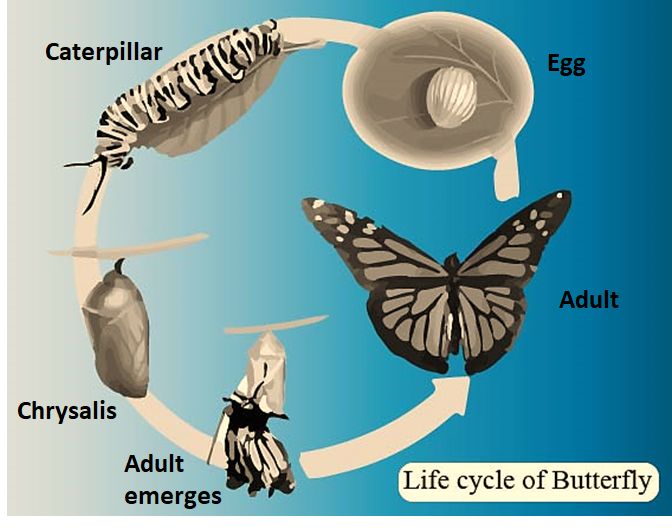
Larvae of butterfly is known as
(a)Maggot
(b)Tumbler
(c)Caterpillar
(d)Cocoon
Answer
501.9k+ views
1 likes
Hint: Larval form is the stage of development. Lavra eats and grows by feeding on their host plants. They collect necessary nutrients from the host required by the developing butterfly.
Complete answer:
Larvae of the butterfly are also known as caterpillars.
The lifecycle of a butterfly:
The butterfly undergoes a process called metamorphosis via four developmental stages i.e. egg, larva, pupa, and adult.
- Egg: Adult female butterfly lays eggs on the plant which will then become the food for the hatching caterpillars. Eggs can be laid during spring, summer, or fall depending on the species of butterfly.
- Caterpillar-the Feeding Stage: The next stage is the larva (aka caterpillar). A caterpillar's sole purpose is to consume food and grow. As the larva grows it splits its skin and sheds it about 4 or 5 times. Food eaten is stored and used later by an adult.
- Pupa-The Transition Stage: When the caterpillar has consumed enough food, it stops feeding and is fully grown. It now becomes a pupa. Cells at this stage start to divide rapidly.
- Adult-The Reproductive Stage: Fully grown mature butterfly having wings, eyes, legs, and all other developed structures.
So, the correct answer is ‘Caterpillar’.
Note:
- Butterfly’s pupa is also known as chrysalis.
- The adult butterfly’s job is to reproduce.
- The butterfly develops through complete metamorphosis and the larval form is different from the adult form i.e. both the forms do not resemble.

Fig: The life cycle of a butterfly showing different developmental stages.
Complete answer:
Larvae of the butterfly are also known as caterpillars.
The lifecycle of a butterfly:
The butterfly undergoes a process called metamorphosis via four developmental stages i.e. egg, larva, pupa, and adult.
- Egg: Adult female butterfly lays eggs on the plant which will then become the food for the hatching caterpillars. Eggs can be laid during spring, summer, or fall depending on the species of butterfly.
- Caterpillar-the Feeding Stage: The next stage is the larva (aka caterpillar). A caterpillar's sole purpose is to consume food and grow. As the larva grows it splits its skin and sheds it about 4 or 5 times. Food eaten is stored and used later by an adult.
- Pupa-The Transition Stage: When the caterpillar has consumed enough food, it stops feeding and is fully grown. It now becomes a pupa. Cells at this stage start to divide rapidly.
- Adult-The Reproductive Stage: Fully grown mature butterfly having wings, eyes, legs, and all other developed structures.
So, the correct answer is ‘Caterpillar’.
Note:
- Butterfly’s pupa is also known as chrysalis.
- The adult butterfly’s job is to reproduce.
- The butterfly develops through complete metamorphosis and the larval form is different from the adult form i.e. both the forms do not resemble.

Fig: The life cycle of a butterfly showing different developmental stages.
Recently Updated Pages
Master Class 9 General Knowledge: Engaging Questions & Answers for Success

Master Class 9 English: Engaging Questions & Answers for Success

Master Class 9 Science: Engaging Questions & Answers for Success

Master Class 9 Social Science: Engaging Questions & Answers for Success

Master Class 9 Maths: Engaging Questions & Answers for Success

Class 9 Question and Answer - Your Ultimate Solutions Guide

Trending doubts
State and prove Bernoullis theorem class 11 physics CBSE

Who built the Grand Trunk Road AChandragupta Maurya class 11 social science CBSE

1 ton equals to A 100 kg B 1000 kg C 10 kg D 10000 class 11 physics CBSE

State the laws of reflection of light

One Metric ton is equal to kg A 10000 B 1000 C 100 class 11 physics CBSE

Difference Between Prokaryotic Cells and Eukaryotic Cells




